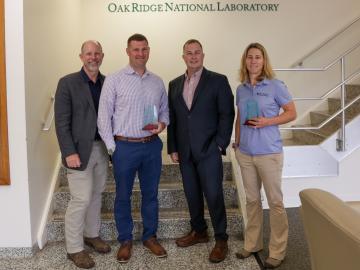
Filter News
Area of Research
- (-) Fuel Cycle Science and Technology (1)
- (-) Materials (55)
- (-) National Security (50)
- Advanced Manufacturing (4)
- Biological Systems (1)
- Biology and Environment (94)
- Biology and Soft Matter (1)
- Computational Biology (1)
- Computational Engineering (1)
- Computer Science (4)
- Energy Science (59)
- Fusion and Fission (5)
- Isotopes (8)
- Materials for Computing (10)
- Neutron Science (103)
- Nuclear Science and Technology (4)
- Quantum information Science (2)
- Supercomputing (117)
News Type
News Topics
- (-) Big Data (5)
- (-) Biomedical (6)
- (-) Clean Water (2)
- (-) Computer Science (30)
- (-) Environment (17)
- (-) Exascale Computing (2)
- (-) Machine Learning (15)
- (-) National Security (35)
- (-) Neutron Science (29)
- (-) Summit (3)
- 3-D Printing/Advanced Manufacturing (19)
- Advanced Reactors (3)
- Artificial Intelligence (20)
- Bioenergy (13)
- Biology (8)
- Biotechnology (1)
- Buildings (4)
- Chemical Sciences (27)
- Composites (5)
- Coronavirus (4)
- Critical Materials (8)
- Cybersecurity (19)
- Energy Storage (25)
- Frontier (2)
- Fusion (5)
- Grid (8)
- High-Performance Computing (7)
- Isotopes (11)
- ITER (1)
- Materials (58)
- Materials Science (52)
- Mathematics (1)
- Microscopy (18)
- Molten Salt (2)
- Nanotechnology (29)
- Nuclear Energy (16)
- Partnerships (15)
- Physics (24)
- Polymers (10)
- Quantum Computing (2)
- Quantum Science (11)
- Security (10)
- Simulation (1)
- Space Exploration (1)
- Transportation (9)
Media Contacts

Cameras see the world differently than humans. Resolution, equipment, lighting, distance and atmospheric conditions can impact how a person interprets objects on a photo.

When the COVID-19 pandemic stunned the world in 2020, researchers at ORNL wondered how they could extend their support and help

Scientists at ORNL used neutron scattering to determine whether a specific material’s atomic structure could host a novel state of matter called a spiral spin liquid.

Researchers at ORNL are tackling a global water challenge with a unique material designed to target not one, but two toxic, heavy metal pollutants for simultaneous removal.

Though Nell Barber wasn’t sure what her future held after graduating with a bachelor’s degree in psychology, she now uses her interest in human behavior to design systems that leverage machine learning algorithms to identify faces in a crowd.

To solve a long-standing puzzle about how long a neutron can “live” outside an atomic nucleus, physicists entertained a wild but testable theory positing the existence of a right-handed version of our left-handed universe.

In front of family and friends, Lt. Col. Jessica Critcher and Maj. Micah McCracken gave their final report on their eye-opening year as ORNL military fellows.

Scientists develop environmental justice lens to identify neighborhoods vulnerable to climate change
A new capability to identify urban neighborhoods, down to the block and building level, that are most vulnerable to climate change could help ensure that mitigation and resilience programs reach the people who need them the most.

ORNL scientists will present new technologies available for licensing during the annual Technology Innovation Showcase. The event is 9 a.m. to 3 p.m. Thursday, June 16, at the Manufacturing Demonstration Facility at ORNL’s Hardin Valley campus.

It’s a simple premise: To truly improve the health, safety, and security of human beings, you must first understand where those individuals are.


